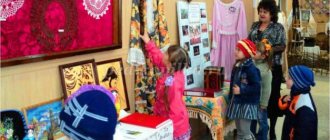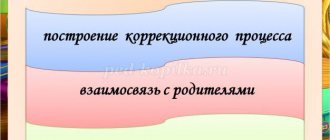Experience in implementing the ethnocultural component in the activities of preschool educational institutions
Rosa Simonova
Experience in implementing the ethnocultural component in the activities of preschool educational institutions
We take beauty and purity from our elders,
Sagas, tales from the past we bring,
Because good remains good
In the past, future and present
V. Vysotsky
Currently, the ethnocultural component has become an acute and pressing problem in education, having broad social, intercultural, international and educational significance. It provides a connection between the processes of socialization, socio-psychological adaptation, sociocultural integration of the student’s personality with his needs for awareness of cultural roots, psychologically strong family ties, and the desire to understand and master the world.
When drawing up educational programs for a preschool institution, the second part recommends an ethnocultural component . this component independently, taking into account the type of institution and the specifics of organizing the educational activities of the teaching staff. In this regard, the problems associated with determining the content and ways of implementing the ethnocultural component seem to be very important from both theoretical and practical points of view.
As historical experience , the need to organize the educational process in preschool educational institutions on an ethnocultural basis was recognized by domestic teachers from the very beginning of their creation in Russia.
Ethnocultural education is a system in which all goals, technologies and content are aimed at the development and socialization of the child’s personality as a subject of an ethnic group and as a citizen of the multinational Russian state. Ethnocultural education implies the introduction of children’s knowledge about their native folk culture into the educational process: familiarizing children with the oral and poetic creativity of the Mordovian people; with the fine and decorative arts of Mordovia; with the historical, geographical and natural history characteristics of the peoples living in Mordovia [1, p. 78].
The following principles are identified for introducing an ethnocultural component into the education of preschool children:
• Reliability – ethnocultural must be reliable.
• Entertaining – the inclusion of an ethnocultural component should evoke interest and an emotional response, satisfying the need to know oneself and the world around us.
• Accessibility – information must be accessible to children of a certain age and have a clear logic of presentation;
• Variability – the information presented must allow for a variety of points of view, based on arguments, evidence, and include anti-stereotypical elements.
• Complexity – cognitive material is presented by different means: demonstrations, verbal story, conversation, visual illustrations, practical experiments , organization of observation, research activities , demonstration of a method of action.
• Polyartism – involves the child’s participation in various types of creative activities and learning many types of crafts.
• Egocentricity - the information provided must affect the interests of the child, satisfy his needs in the ethnocultural sphere , be significant for him, contribute to his self-development, self-awareness and self-improvement.
• The principle of continuity and consistency in the study of cultures. It is important to understand that children cannot fully understand all the many ethnic cultures of Russia and the world. First of all, children should know the culture of their people and region well [2, p. 110].
Compliance with these principles, taking into account the ethnocultural issues of the content of education, is most consistent with the realities of the present time and the future development of society and each individual.
In our kindergarten we work according to the program “We live in Mordovia”
edited by a team of authors
(O. V. Burlyaev, L. P. Karpushin, E. N. Kirkin, etc.)
[4].
When working on the topic “Education of National Culture”,
much attention is paid to introducing children to the origins of regional culture and developing interest in national traditions. A huge role in cultivating interest in national culture is played by the content of the subject-development environment in the group and kindergarten as a whole.
National corners have been created in kindergarten groups, with the help of materials from which we expand children’s understanding of the history of Mordovia and the Mordovian people, who have long lived in this territory, and give children a general idea of the way of life of the Mordovian people in the past and in the present. In the national corner there are national costumes. Here we introduce preschoolers to parts of national clothing and the features of the Mordovian costume (Erzya, Moksha)
.
In the corners there are also Russian and Mordovian flags, photographs of the sights of the city of Saransk, books on relevant topics, in order to visually familiarize children with their hometown.
We carry out artistic and aesthetic development by introducing children to works of Mordovian decorative and applied art, Mordovian folk toys (whistle bird, brownie, illustrations to works of Mordovian children's literature.
In art , we try to evoke in children an emotional response to the brightness of the color images and the originality of the shapes of these products, with the children we cut out and decorate them with Mordovian patterns, a towel for their mother, and we also introduce children to the national patterns of the Mordovians for drawing. In the process of becoming familiar with Mordovian patterns, children develop the ability to distinguish and name the three-dimensional geometric elements of the Mordovian ornament ( “cross”
,
“tick”
,
“herringbone”
,
“rhombus”
, arrange them rhythmically. Preschoolers get acquainted with the color scheme characteristic of Mordovian patterns (red - black - white), and also learn to combine colors harmoniously.
When working with children on walks and in free activities , kindergarten teachers use Mordovian outdoor games: “Wolves”
(
“Vergiznese”
– erz.,
“Vrgazsa”
– moksh.,
“In sharagu-varagu”
,
“In circles”
(
“Krugso”
– erz.,
“Krugsa”
– moksh.,
“In cranes”
(
“Karginese”
– erz.,
"Kargosa"
- moksh.,
"Into the cockerel"
(
"Atyakshkes"
- erz.,
"Atyakshsa"
- moksh.,
"Into the crow"
(
"Varakaso"
-erz.,
"Varsisa"
- moksh.,
"Into handkerchiefs "
(
"Patsinese"
- erz.,
"Rutsyanyasa"
- moksh.,
"Into a blind old woman"
(
"Sokorbabaso"
- erz.,
"Sokorbabasa"
- moksh.), etc. During the games, children learn to independently organize familiar games and play the role of leader and driver in outdoor games.
At music classes, preschoolers get acquainted with folk music (of the peoples inhabiting Mordovia - erz. folk song; “Ak Kalach”
(
"White Kalach"
);
tat. adv. song; “Narmonnyatne, lieda”
(
“Birds, fly”,
etc.) and music
by composers of Mordovia (Listening - “My Beloved Land”
, music by A. Averkin, lyrics by P. Chernyaev;
“In sunny Mordovia”
, music by Gen. Suraev-Koroleva, lyrics by A. Gromykhin;
“Tyutyu-balyu”
, music by L. P. Kiryukov, lyrics by F. Atyanin;
“Umarina”
(
“Apple tree”
, music by N. Boyarkin; singing -
“Bayu, bayu , bye, bye "
, erza folk song; moksha folk song;
"Seelne"
(
"Hedgehog"
, music and lyrics by G. I. Suraev-Koroleva and others). Children develop phonemic hearing, improve intonation expressiveness of Moksha
(Erzya)
speech.
Together with the Mordovian Republican Children's Library, thematic events are regularly held ( “Mordovian fairy tales and toys”
).
Thematic exhibitions are organized at the event, where colorful illustrated books, ancient Mordovian toys are presented: clay whistles, dolls, etc. Library staff conduct various thematic games ( “Raven and Chickens”
, Mordovian dances, and cartoon shows (“Kuigorozh”) are also held. Children really enjoy these events.
Through excursions and works of literature, we continue to get acquainted with the sights of our hometown. A primary idea of the peoples inhabiting Mordovia and their languages is formed; the name of the city in which the children live is fixed, they get acquainted with the names of the streets where they live, with attractions located near the kindergarten or the child’s place of residence (monuments, schools, clinics, cinemas, shops, etc.)
.
One of the important pedagogical conditions for the formation of ethnocultural competence of preschoolers is the active involvement of parents in this activity . We use the potential of the family by including the following activities in long-term planning of work with parents :
– participation of parents (in holidays and entertainment with ethnocultural themes );
– consultations for parents, the topics of which are “Russian or Mordovian traditions in raising children”
;
“How to make a folk toy with your kids”
;
– a minute of communication with the child;
– wall newspaper “Mordovian eikakshtne”
.
All work carried out on ethnocultural education is aimed at developing in the child a sense of wonderful, tolerant attitude and respect for people living nearby. A child will love and truly appreciate his region if we, teachers, teach him this.
Methods of ethnocultural education in working with preschoolers and primary schoolchildren
Leontyeva Irina
Methods of ethnocultural education in working with preschoolers and primary schoolchildren
Annotation:
The article reveals the concept of method in ethnocultural education and examines the main methods of ethnocultural education in working with preschoolers and primary schoolchildren.
Keywords:
method, methodology, ethnic culture, ethnocultural education.
Ethnonational aspects are becoming increasingly important in the life of Russian society and the entire world community. And since education plays a special role in the formation of a citizen’s personality in a multicultural, multiethnic country, which relies in its development on the spiritual traditions of ancestors, protecting the values developed by the centuries-old history of cultural creativity and interaction of ethnic groups, the importance of developing an effective methodology for ethnocultural education is constantly increasing. Of particular importance is that within the framework of multicultural education, the value and uniqueness of the culture of each people, regardless of their size, is recognized.
Ethnic culture is a set of ethno-differentiating and ethno-integrating characteristics of a given culture, which, on the one hand, ensure the unity of each ethnic group, and on the other, the transmission of this unity from generation to generation [3, p. 39]. Awareness and preservation of ethnic culture not only contributes to an individual’s ethnic self-identification, but also makes it possible to preserve the diversity of cultural forms of the peoples of the world, enriching world culture.
Ethnocultural education is aimed at preserving the ethnocultural identity of the individual through familiarization with the native language and culture while simultaneously mastering the values of world culture [3, p. 39].
In ethnocultural education, pedagogical methods are used, in particular the methods of ethnopedagogy and folk pedagogy.
Pedagogical methods are ways of influencing the consciousness, will, feelings, and behavior of students in order to develop in them the qualities specified for the purpose of education [4, p. 173].
Speaking about the methods of ethnocultural education, it should be understood that ethnic culture is manifested in literally all areas of the life of an ethnos: in language, in raising children, in clothing, in the structure of the home, workplace, household, and especially in folklore. The formation of ethnic culture is influenced by natural conditions, language, religion, as well as the mental makeup of the ethnic group; an important element of ethnic culture is the self-name of the people (ethnonym). Accordingly, the goal of ethnocultural education is to help children enter the world of folk culture, and its content orients the upbringing and development of the child’s personality towards the formation of so-called basic sociocultural identities, which, as a rule, are lifelong and set the location and self-perception of a person in the world.
Ethnic culture has two components: material (it includes tools, buildings, clothing, food, means of transportation, housing) and spiritual (it includes morals, customs, customary laws, values, knowledge, beliefs, types of folk art). Because of this, ethnocultural education presupposes familiarization with both the material and spiritual culture of an ethnic group.
Taking into account the above, methods and techniques of ethnocultural education are selected.
Methods of ethnocultural education and ethnocultural upbringing include: persuasion, example, demands, order, explanation, belief, training and exercise, wish and blessing, request, advice, hint, approval, reproach, reproach, persuasion, prohibition. The means of education include: work, play, communication, oral folk art (nursery rhymes, counting rhymes, riddles, proverbs, sayings, songs, fairy tales and legends, traditions, etc.) [3, p. 13].
The content of cultural education can be implemented in four directions of the formation and development of a child: physical, cognitive-speech, social-personal, artistic-aesthetic. Basic and additional educational programs (especially in preschool educational institutions and primary classes) include various traditions and customs, folk games, and introduce preschoolers and primary schoolchildren to various forms of folk art. At the same time, children are provided with cultural and historical information that expands their knowledge about their country, state, state symbols, and native land. However, all programs should not only implement a content-based knowledge approach, but also provide for the development of the basic foundations of personality: the formation of an awareness of one’s national “I”, respect and tolerance for people regardless of their race and nationality, interest in the history of the country, native land, city , village.
At the same time, both in a preschool educational institution and at school, as part of additional and basic education, attention can be paid in general terms to studying the foundations of Orthodox, Catholic and Muslim culture, familiarity with the history, traditions and customs of the Russian peoples.
Conducting integrated and combined classes with preschoolers allowed teachers to determine the range of methods and techniques of ethnocultural education:
a) methods that form ethnocultural consciousness: conversations, examination of original household items (costumes, dishes, jewelry), paintings and reproductions, illustrations, photographs, slides; viewing and listening to audio and video recordings; “Journey along the River of Time”, “Travel on the Map”, etc.); method of ethnic toponymy, i.e. familiarization with geographical names of the area; heuristic conversation “Family traditions yesterday and today”, which is based on comparisons and questions [1; 2];
b) methods that promote the development of an emotionally evaluative attitude: reflective and game methods (sensory-emotional games “Guess whose national costume”, “Favorite colors of peoples”, “Guess whose national dish”, “Who needs what for work”) [1 ; 2];
c) methods of effective practical stimulation: cartographic method (“Travel on the map”, “Journey into the history of the region, the life of the people, things, family, language”), modeling (“Models of folk calendars”, “Labor in the Southern Urals”, “Dwellings” peoples of the Southern Urals”, etc.), prototyping (“Caves of the Southern Urals”, “Natural zones of the Urals”) [1; 2].
Great importance must be given to working methods that are part of a particular method. In the first group, the main techniques are: explanation, reminder, comparison, comparison, problematic questions, putting forward hypotheses, riddles; teaching children to pose questions, argue, reason (“if ... then”), and prove. The second group of methods for ethnocultural education of students includes: surprises; the introduction of folk and fairy-tale characters, naive anthropomorphism (“What the kurai will tell us about”), performing game actions, roles, sketches, creating situations of success and fixing them, “transforming” into imaginary heroes. We include the following techniques in the third group: creative tasks, drawing up a collage, a “family tree”, collecting folk items, organizing meetings of guests of different nationalities (game trainings) [1; 2].
conclusions
A method is a systematized set of steps and actions that are aimed at solving a specific problem or achieving a specific goal.
A methodology is a set of methods, techniques, tested and studied to perform a specific job.
Ethnic culture is a set of ethno-differentiating and ethno-integrating characteristics of a given culture, which, on the one hand, ensure the unity of each ethnic group, and on the other, the transmission of this unity from generation to generation.
Ethnocultural education is education aimed at preserving the ethnocultural identity of an individual through familiarization with the native language and culture while simultaneously mastering the values of world culture.
The general methodology of ethnocultural education of preschoolers and primary schoolchildren is aimed at implementing one of the areas of their social, personal and cultural development, and ensures the active development of children's national and world cultural heritage and helps to increase the ethnocultural education of not only students, but also teachers.
1. Babunova, E.S. Methodology for the development of ethnocultural education in preschool children / E.S. Babunova [Electronic resource]. ― Access mode: https://school2100.com/upload/iblock/a97/a973d02b57c00b33abf1a36fa2906715.pdf (access date: 09/20/2019).
2. Babunova, E.S. Program for the education and development of preschool children based on the ideas of folk pedagogy: scientific and theoretical foundations of the program [Text] / E.S. Babunova, F.V. Gradusova, L.S. Ignatskaya et al. - Magnitogorsk: MaSU, 2000. - 40 p.
3. Latyshina L.I. Ethnopedagogy: textbook. - 2nd ed., revised. and additional [Text] / L.I. Latyshina, R.Z. Khairullin. ― M.: Yurayt, 2014. ― 532 p.
4. Nezdemkovskaya, G.V. Ethnopedagogy: textbook [Text] / G.V. Nezdemkovskaya. ― M.: Academic project; Alma Mater, 2011. - 225 p.



